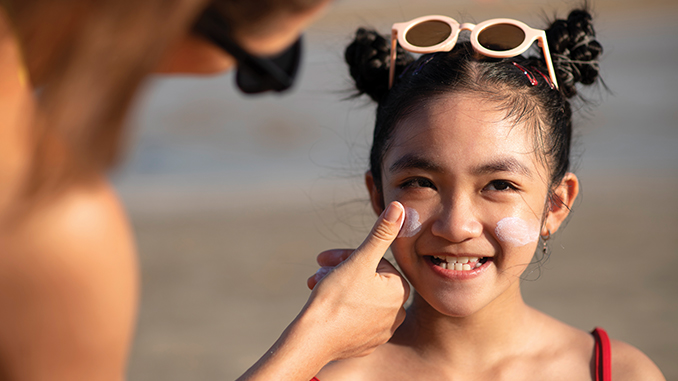
Use these tips to choose the best sunscreen for you and your family this summer.
Published: April 30, 2024
By: Victoria Mikota
Wearing sunscreen is a must and the only way you can protect your skin from the damaging effects of UV rays. While sunscreen comes in many different shapes and sizes, you’ll want to buy something good for your skin that helps ensure full protection. In this guide, we’ll help narrow down what to look for when choosing sunscreen for both you and your family.
#1. Avoid Harsh Ingredients
When choosing something to put on your skin, it’s so important to pay attention to the chemical makeup of the products you’re using. While some skincare products like alpha hydroxy acid (AHA) and beta hydroxy acids (BHA) are meant to exfoliate and penetrate skin to clear toxins, sunscreen should be extremely gentle. Harsh ingredients can irritate all skin types, so try to steer clear of sunscreens containing fragrances, chemicals, and dyes.
#2. Choose a Mineral Sunscreen
At the end of the day, the best sunscreen is the one you’ll wear. With this being said, mineral and chemical sunscreen have key differences. With mineral sunscreen, the formula sits on top of the skin and blocks rays at the surface using zinc oxide and titanium dioxide. On the other hand, chemical sunscreen absorbs rays using ingredients like oxybenzone, avobenzone, octisalate, octocrylene, homosalate, or octinoxate. Mineral sunscreens suit those with sensitive or acne-prone skin, but the formulas are often thicker and can leave a white cast. Chemical sunscreens are usually lighter, clearer, and more enjoyable to wear, but the active ingredients can irritate sensitive or acne-prone skin. It’s important to note that chemical sunscreen is not safe for children or pregnant women.
#3. Look for Broad Spectrum Coverage
Make sure your sunscreen offers coverage from UVA and UVB rays. While both types of rays cause damage to the skin, UVA rays tend to affect our skin more because they penetrate deeper than UVB. Look for “broad spectrum” protection on the label!
#4. Select an SPF of 30 or Higher
Pay attention to SPF labels on sunscreen bottles and look for sunscreen with an SPF of at least 30. For broad-spectrum sunscreen, an SPF of 30 will prevent about 97 percent of UVB rays from reaching your skin, while an SPF of 50 will only allow about two percent of rays through.
#5. Choose the Right Formula for Skin Type
Since sunscreen is not a one-size-fits-all product, it’s important to find one that works best for you. Some sunscreens can leave behind a white, milky cast; they might be sticky; or even burn if they get in your eyes! Here’s a good guide to follow:
Sensitive skin: For sensitive skin, opt for a fragrance-free sunscreen to limit reaction and inflammation. Physical sunscreen is less irritating and better suited for sensitive skin because it sits on top of your skin and works immediately.
Oily skin: With oily skin, you want to steer clear of most liquid sunscreens that can exacerbate oil production. Opt for a matte or powder sunscreen to keep your skin shine-free.
Acne-prone skin: For acne-prone skin, you want to stay away from excessive product buildup that can clog pores. Instead, look for a matte option that will absorb oil and limit shine.
Mature: For mature, aging skin, look for a sunscreen that has added skincare ingredients to help plump and smooth fine lines.
#6. Pick the Right Sunscreen for Your Skin Tone
Over the years, skincare has changed in a positive way for melanated people. While the selection of sunscreen has increased for those with darker skin tones, many melanated individuals prefer chemical sunscreen over mineral due to the white cast mineral sunscreen leaves behind. Chemical sunscreens are less likely to leave behind a white cast on darker skin tones, but as always, check ingredients to ensure you’re protecting your skin in more ways than one.
#7. Try Out Spray or Stick Formulas
Of course, you can have more than one formula for at-home application and on-the-go. A spray formula is a great option for reapplication. It’s easier to cover hard-to-reach areas and easier to determine which spots you missed. Just be sure to rub in the spray after application to ensure proper coverage. Another sunscreen application method is stick. Solid sunscreens that come in a stick or compact form are easy to apply on the go and make for a quick reapplication.
Remember, the best sunscreen is the one you’re already using. If you want to take the extra steps to avoid pesky chemicals, and unnecessary irritants, or find something gentle on the skin, we recommend reading labels and choosing what works best for you.
